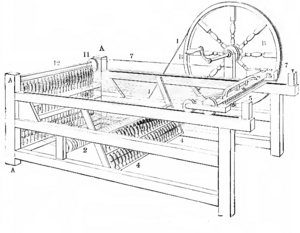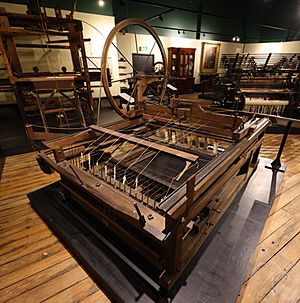Spinning Jenny facts for kids
The spinning jenny was a special machine that could spin many threads of yarn at once. It was a very important invention during the early Industrial Revolution because it helped make textile manufacturing much faster. James Hargreaves invented it in England around 1764-1765.
This machine made it much easier to produce cloth. Before, a worker could only spin one spool of yarn at a time. With the spinning jenny, one person could spin eight or more spools at once! Later versions could even spin up to 120 spools. The yarn made by the jenny wasn't super strong at first. But then, Richard Arkwright invented the water frame, which used water power to make stronger yarn. The spinning jenny was a big step towards the factory system, where many machines and workers were brought together in one place to make goods.
Contents
How the Spinning Jenny Changed Things
The spinning jenny was invented by James Hargreaves. He lived in a town called Oswaldtwistle, near Blackburn, England. Blackburn was known for making "Blackburn greys," which were cloths with linen and cotton.
Back then, people couldn't make enough cotton yarn to keep up with the demand from cloth makers. An earlier invention, the flying shuttle by John Kay in 1733, had already made weaving much faster. This meant weavers needed a lot more yarn. Hargreaves thought about how to make spinning faster, and his spinning jenny helped solve this problem by letting spinners make much more yarn. The machine made a rough kind of thread.
What Was the Spinning Jenny Like?
Hargreaves designed the spinning jenny with a metal frame and eight wooden spindles at one end. Spindles are like sticks that yarn wraps around. Eight rovings (which are loose ropes of fibers) were attached to a bar on the frame. These rovings went through two wooden bars that could be squeezed together.
The spinner would pull these bars with their left hand, which stretched the thread. With their right hand, they would quickly turn a wheel. This made all the spindles spin, twisting the fibers into thread. When the bars were moved back, the thread would wind onto the spindle. A special wire helped guide the threads onto the right spot on the spindle.
Why Cotton Became So Important
In the 1600s, England was famous for its wool cloth. The cotton industry was very small. Laws were even made to protect the wool industry and stop people from importing cheap cotton cloth from places like India.
However, people really liked the colorful cotton prints. So, instead of importing finished cotton, people started importing "grey cloth" (cotton that hadn't been dyed or printed yet) and finishing it in England. Business people in Lancashire started making their own grey cloth using linen and cotton.
Over time, laws changed, and it became okay to use colored cotton. This created a huge demand for woven cloth. By 1764, England was importing a lot more cotton.
Life in Northern England Before the Jenny
Before canals, railways, and better roads, goods like cloth and cotton were moved by packhorse. Merchants would travel with their goods and money, often being away from home for a long time.
Before 1720, a handloom weaver would spend part of their day buying yarn from neighbors. Spinning and carding (preparing the fibers) were often done by families at home to earn money. It took three carders to prepare enough fiber for one spinner, and up to three spinners to make enough yarn for one weaver. Everyone in the family, from youngest to oldest, helped with this work. Weavers would then take their finished cloth to market to sell.
Around 1740, things started to change. Cloth masters would give raw cotton to weavers and then collect the finished cloth. The weaver would organize the carding, spinning, and weaving at home. Later, these masters became middlemen, taking the grey cloth to markets in Manchester to sell to merchants who would finish it.
Making a 12-pound piece of cloth by hand took about 14 days. The money earned was split between weaving, spinning, and carding. So, by 1750, a basic system for making and selling cloth was in place.
In 1738, John Kay improved the loom with his flying shuttle. This invention allowed one weaver to make twice as much cloth. Even though some workers worried about losing their jobs, the flying shuttle was adopted. This put a lot of pressure on spinners to produce yarn much faster.
The need for more yarn to feed these faster looms led to the invention of machines like the spinning jenny. This was a key moment that helped start the Industrial Revolution.
The Jenny's Impact
Hargreaves tried to keep his invention a secret at first. He made several jennies for his own growing business. As more yarn was produced, its price dropped. This made many spinners in Blackburn angry because it affected their income. Eventually, a group of them broke into his house and destroyed his machines. This forced Hargreaves to move to Nottingham in 1768.
In Nottingham, a city known for making knitted goods, he secretly continued to make jennies. On July 12, 1770, he got a patent for his invention, the Spinning Jenny.
By this time, many people in Lancashire were already using copies of his machine. Hargreaves tried to take legal action against them. The manufacturers offered him £3,000 to settle, but he wanted more. The case eventually failed because it was found that he had sold some jennies before getting his patent.
The spinning jenny was a big success, especially because the flying shuttle had already made weaving faster. However, it still needed the rovings to be prepared by hand, which limited how much could be made. The spinning jenny was widely used in the cotton industry until about 1810. It was later replaced by the spinning mule, which was an even better machine. The jenny was also adapted to make a type of yarn called "slubbing."
Benefits of the Spinning Jenny
The spinning jenny could hold many balls of yarn at once. This meant it could make a lot more yarn in a much shorter time. It also helped to lower the overall cost of making yarn and cloth.
The Story Behind the Name
The most common story about how the spinning jenny got its name is that one of Hargreaves' daughters (or his wife), named Jenny, accidentally knocked over their spinning wheel. The wheel kept working, but with the spindle pointing straight up. Hargreaves supposedly realized that spindles didn't have to be horizontal and could be placed vertically in a row.
However, church records show that Hargreaves had several daughters, but none were named Jenny, and neither was his wife. A more likely explanation is that "jenny" was a short way of saying "engine."
Some people also claimed that Thomas Highs of Leigh invented a similar machine. Another story says that Thomas Earnshaw invented a spinning device but destroyed it because he worried it would take jobs away from poor people.
Other pages
Images for kids
See also
 In Spanish: Hiladora Jenny para niños
In Spanish: Hiladora Jenny para niños
- Cotton mill
- Luddite
- Spinning mule
- Textile manufacturing during the Industrial Revolution
- Textile manufacturing
- Timeline of clothing and textiles technology





